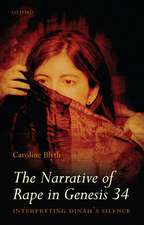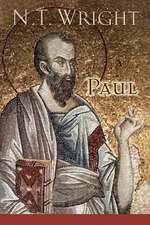The Gospel of the Beloved Disciple: A Work in Two Editions
Autor Dr Herman C. Waetjenen Limba Engleză Paperback – 12 mar 2014
| Toate formatele și edițiile | Preț | Express |
|---|---|---|
| Paperback (1) | 263.93 lei 6-8 săpt. | |
| Bloomsbury Publishing – 12 mar 2014 | 263.93 lei 6-8 săpt. | |
| Hardback (1) | 414.52 lei 6-8 săpt. | |
| Bloomsbury Publishing – 31 dec 2005 | 414.52 lei 6-8 săpt. |
Preț: 263.93 lei
Preț vechi: 298.75 lei
-12% Nou
Puncte Express: 396
Preț estimativ în valută:
50.50€ • 54.01$ • 42.11£
50.50€ • 54.01$ • 42.11£
Carte tipărită la comandă
Livrare economică 17 aprilie-01 mai
Preluare comenzi: 021 569.72.76
Specificații
ISBN-13: 9780567655356
ISBN-10: 0567655350
Pagini: 480
Dimensiuni: 156 x 234 x 25 mm
Greutate: 0.68 kg
Editura: Bloomsbury Publishing
Colecția T&T Clark
Locul publicării:London, United Kingdom
ISBN-10: 0567655350
Pagini: 480
Dimensiuni: 156 x 234 x 25 mm
Greutate: 0.68 kg
Editura: Bloomsbury Publishing
Colecția T&T Clark
Locul publicării:London, United Kingdom
Notă biografică
Herman
C.
Waetjenis
emeritus
professor
of
the
New
Testament
at
San
Francisco
Theological
Seminary,
USA.
Cuprins
1.Introduction2.The
Prologue3.The
Role
of
John
as
Witness4.The
Beginning
of
Jesus'
Ministry5.Seeing
and
Therefore
Believing
and
Believing
in
Order
to
See6.Jesus
and
Nicodemus7.Romancing
the
Samaritan
Woman8.Failure
in
Jerusalem9.The
Second
Passover10.Jesus
at
the
Festival
of
Booths
in
Jerusalem11.Success
in
Jerusalem12.The
Seventh
Sign13.Jesus
Closes
His
Ministry14.Incarnation
and
the
New
Human
Being15.Jesus'
Farewell
Discourse16.Arrest,
Trial,
Death,
and
Burial17.Resurrection
and
the
New
Creation
Recenzii
To
deep
and
faithful
immersion
in
the
text
of
this
ancient
document
itself
Professor
Waetjen
adds
a
truly
comprehensive
knowledge
of
the
modern
critical
literature
and
his
own
interpretive
sensitivity.
How
Jesus
can
be
both
the
image
of
God
and
the
physical,
earthly
human
being,
son
of
Joseph,
is
only
one
of
the
Johannine
riddles
to
which
Waetjen
brings
new
insight.
An
illuminating
interpretation.
Herman Waetjen once again rewards his readers with not merely the challenge but also an accessible yet profoundly informed reading of a biblical text. This time he turns his erudition and discerning eye to the Fourth Gospel, and he emerges from this mine, as well, with precious ore. Scholars and students alike not only will acquire valuable capital by investing time in Herman's project, but they will also acquire tools for their own creative engagement of life rather than a call to escape from the terrors of history. Herman encounters dichotomies and dualisms and shows us how to view them constructively as complementarities and dialectical adventures. In a world of simplistic hard-line alternatives, it is refreshing and empowering to encounter a challenge to do the rigorous work of (re-)engaging of, and (re-)thinking about, what we thought were settled issues to discover new light and true riches.
Herman Waetjen once again rewards his readers with not merely the challenge but also an accessible yet profoundly informed reading of a biblical text. This time he turns his erudition and discerning eye to the Fourth Gospel, and he emerges from this mine, as well, with precious ore. Scholars and students alike not only will acquire valuable capital by investing time in Herman's project, but they will also acquire tools for their own creative engagement of life rather than a call to escape from the terrors of history. Herman encounters dichotomies and dualisms and shows us how to view them constructively as complementarities and dialectical adventures. In a world of simplistic hard-line alternatives, it is refreshing and empowering to encounter a challenge to do the rigorous work of (re-)engaging of, and (re-)thinking about, what we thought were settled issues to discover new light and true riches.











